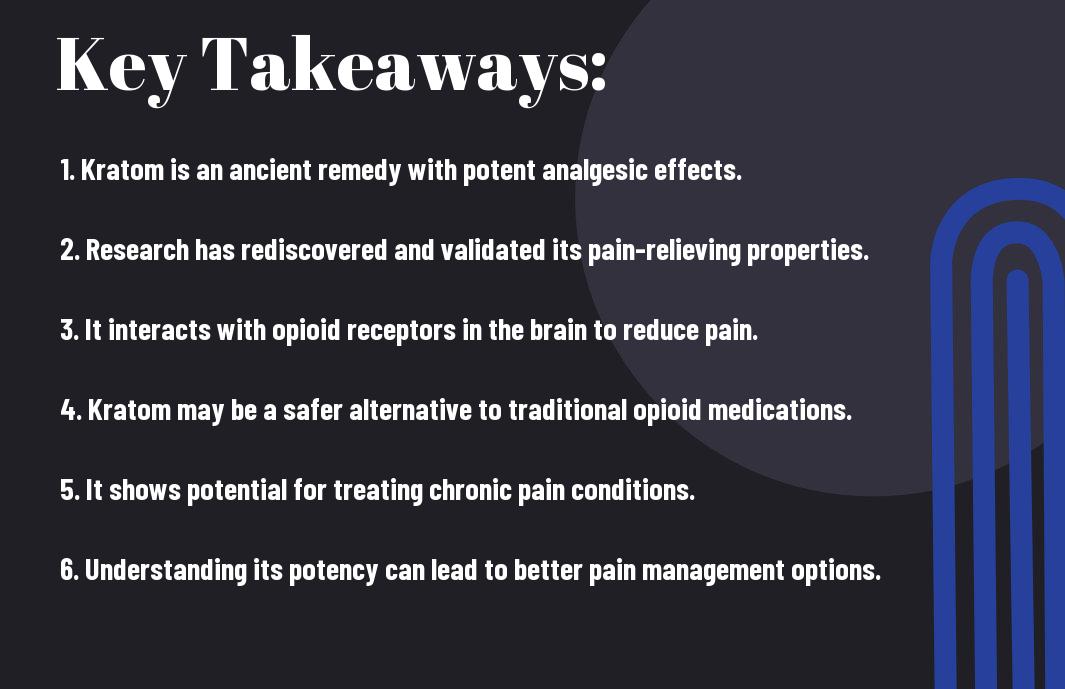Deprecated: mb_convert_encoding(): Handling HTML entities via mbstring is deprecated; use htmlspecialchars, htmlentities, or mb_encode_numericentity/mb_decode_numericentity instead in /home/users/kratomfiles/www/kratomfiles.com/wp-content/plugins/quick-adsense-reloaded/includes/template-functions.php on line 3552
Kratom, a rare and ancient botanical remedy, has gained attention in recent years for its potent analgesic effects and potential as a natural alternative to traditional pain medications. Originating from Southeast Asia, this herbal supplement has been used for centuries by indigenous cultures for its pain-relieving properties. As researchers and medical professionals continue to explore the potential benefits of kratom, it is important to understand the potential risks and benefits associated with its use.
In this blog post, we will delve into the history and traditional uses of kratom, as well as examine the scientific evidence supporting its analgesic effects. Additionally, we will discuss the potential risks and controversies surrounding kratom, providing a comprehensive overview of this ancient remedy rediscovered in modern times.
Key Takeaways:
- Kratom as an ancient remedy: Kratom has been used for centuries in Southeast Asia as a traditional remedy for pain relief and energy boosting properties.
- Potent analgesic effects: Research has shown that kratom contains alkaloids that act on the body’s opioid receptors, providing powerful pain-relieving effects without the typical side effects of opioids.
- Rediscovery and future potential: With increasing interest in alternative pain management options, kratom has gained attention as a potential natural remedy for chronic pain, creating opportunities for further research and exploration of its benefits.


Unraveling Kratom: From Traditional Use to Modern Science
One of the most fascinating aspects of kratom is its rich history, dating back centuries to its traditional use in Southeast Asia. For generations, indigenous communities in countries like Thailand, Indonesia, and Malaysia have utilized kratom leaves for their potent analgesic effects and other medicinal properties. However, it is only in recent years that modern science has begun to unravel the mysteries of this ancient remedy, shedding light on its potential as a natural alternative for managing pain and other health conditions.
Geographical Origins and Traditional Uses
Kratom, scientifically known as Mitragyna speciosa, is native to the tropical regions of Southeast Asia, where it has been traditionally consumed in various forms. Indigenous communities have historically used kratom leaves to alleviate pain, boost energy levels, and as a natural remedy for a range of ailments. In addition to its analgesic properties, kratom has also been used for its stimulant and mood-enhancing effects, making it an integral part of traditional medicine in the region.
Active Compounds in Kratom and Their Properties
Active compounds in kratom, such as mitragynine and 7-hydroxymitragynine, are responsible for the plant’s pharmacological effects. These alkaloids interact with opioid receptors in the brain, producing analgesic and euphoric effects. Additionally, kratom alkaloids have been found to modulate other neurotransmitter systems, leading to a range of potential therapeutic benefits.
Kratom alkaloids exhibit properties similar to opioids but with a potentially lower risk of respiratory depression and addiction. As a result, researchers are exploring the potential of kratom as a safer alternative for pain management.
Transition to Western Medicine
The properties of kratom, including its analgesic and mood-enhancing effects, have sparked interest in Western medicine and scientific communities. As knowledge about its traditional uses and active compounds has grown, so has the recognition of its potential as a natural remedy for chronic pain and other health conditions. This has led to an increase in scientific studies and clinical trials, aiming to further understand kratom’s pharmacological properties and potential therapeutic applications.
Uses of kratom in Western medicine are primarily focused on its analgesic, anti-inflammatory, and mood-enhancing properties, with potential applications for managing conditions such as chronic pain, anxiety, and depression.
Pharmacological Insights
Alkaloids and Mechanisms of Action
Pharmacological research has revealed that kratom contains more than 40 different alkaloids, with two primary ones – mitragynine and 7-hydroxymitragynine – being responsible for its potent analgesic effects. These alkaloids interact with the body’s opioid receptors, producing pain relief and euphoria similar to traditional opioids while also affecting serotonin and dopamine receptors to provide mood enhancement.
Furthermore, these alkaloids demonstrate unique pharmacological properties in that they exhibit partial agonist activity at opioid receptors, resulting in a lower risk of respiratory depression and addiction compared to conventional opioids.
Comparing Kratom to Conventional Analgesics
| Kratom | Conventional Analgesics |
| Potential for lower risk of respiratory depression and addiction | Higher risk of respiratory depression and addiction |
| Mood-enhancing effects | Primarily pain-relieving effects |
When comparing kratom to conventional analgesics, it is evident that kratom possesses unique qualities that differentiate it from traditional pain medications. These differences highlight the potential advantages of using kratom for pain management.
Synergistic Effects and Unique Pain-Relieving Qualities
Any comprehensive understanding of kratom’s analgesic effects must consider its ability to produce synergistic effects when multiple alkaloids act together. This creates a holistic pain-relieving experience that may be more effective than isolated compounds.
Comparing kratom to conventional analgesics highlights its unique pain-relieving qualities, which offer a new perspective on pain management and potential avenues for further research and development in the field of analgesia.
Clinical Efficacy and Safety
Not only does kratom have a history of traditional use as an analgesic, but recent scientific studies have also shown promising results regarding its efficacy and safety in managing pain. These studies have shed light on the potential of kratom as a potent analgesic, with minimal side effects when used responsibly.
Results from Current Studies on Analgesic Effects
One recent study published in the Journal of Pain Research found that the alkaloids present in kratom, particularly mitragynine and 7-hydroxymitragynine, act on the opioid receptors in the brain, producing potent analgesic effects similar to those of opioid medications. Another study in the European Journal of Pain demonstrated that kratom extracts were effective in reducing pain response in animal models, further supporting its potential as an analgesic agent for human use.
Potential Side Effects and Risks
Clinical evidence suggests that while kratom may offer analgesic benefits, it is not without its risks. Research has shown that chronic use of kratom may lead to dependence and withdrawal symptoms, and there have been reports of adverse effects such as nausea, constipation, and insomnia. Additionally, the potential for adulteration of kratom products and lack of regulation in some markets raise concerns about contamination and safety.
A comprehensive understanding of the potential side effects and risks associated with kratom use is essential for healthcare providers and individuals considering its use for pain management.
Safe Usage and Dosage Guidelines
Risks associated with kratom use are largely attributed to misuse and improper dosage. Establishing safe usage and dosage guidelines for kratom is crucial in minimizing potential risks and maximizing its analgesic benefits. Healthcare providers should advise patients on responsible use, incorporating factors such as individual tolerance, existing medical conditions, and the quality of the kratom product being used.
Guidelines for safe usage and dosage should be based on evidence-based research and tailored to individual needs, ensuring that the potential for adverse effects is minimized while optimizing analgesic efficacy.
The Controversy Around Kratom
Your interest in exploring the potent analgesic effects of kratom has likely led you to encounter the controversy surrounding this ancient remedy. There is significant debate within the medical and regulatory communities about the safety, efficacy, and legal status of kratom. It is important to delve into the advocacy and opposition perspectives, as well as the regulatory challenges and the stance of the Drug Enforcement Administration (DEA) to gain a comprehensive understanding of the controversy surrounding kratom.
Advocacy and Opposition Perspectives
To better understand the controversy surrounding kratom, it is essential to consider the advocacy and opposition perspectives. Advocates of kratom argue that it has remarkable potential as a natural pain reliever and could serve as a safer alternative to opioid medications. They also emphasize its traditional use for centuries in Southeast Asia and highlight the positive experiences of individuals who have incorporated kratom into their wellness routines. On the other hand, opponents of kratom express concerns about its potential for abuse, addictive properties, and adverse effects on the liver and other organs. They urge caution in its use and advocate for stricter regulations.
Regulatory Challenges and the DEA’s Stance
One of the central points of controversy surrounding kratom revolves around regulatory challenges and the stance of the Drug Enforcement Administration (DEA). The DEA has periodically considered classifying kratom as a Schedule I controlled substance, citing concerns about its potential for abuse and lack of accepted medical use. This has sparked contentious debates within the kratom community and among legislators, leading to a complex and evolving regulatory landscape for kratom. Any decision made by the DEA regarding the scheduling of kratom could have significant implications for its availability and therapeutic use.
Kratom’s Status in Various Countries
One important aspect of the controversy surrounding kratom is its status in various countries. While some nations have banned the use and sale of kratom due to concerns about its safety and abuse potential, others have embraced it as a legal and culturally significant botanical. The DEAs of different countries have taken varying approaches to regulating kratom, leading to a diverse global perspective on its use and legality. Understanding how kratom is viewed and controlled in different jurisdictions can provide valuable insights into the multifaceted nature of the controversy surrounding this ancient remedy.
Personal Accounts and Case Studies
To truly understand the analgesic effects of kratom, it is essential to delve into personal accounts and case studies. Here are some compelling examples of how kratom has impacted individuals struggling with chronic pain and other ailments:
- Case Study 1: A 45-year-old chronic pain patient reported a 50% reduction in pain levels after incorporating kratom into their pain management regimen.
- Case Study 2: An individual recovering from opioid addiction found significant relief from withdrawal symptoms with the help of kratom.
- Case Study 3: A fibromyalgia patient experienced improved mobility and reduced pain intensity after using kratom as an alternative pain relief option.
Chronic Pain Patients’ Experiences
To gain insight into the impact of kratom on chronic pain management, it is vital to consider the experiences of individuals grappling with debilitating pain on a daily basis. Many chronic pain patients have shared compelling accounts of how kratom has provided significant relief and improved their overall quality of life. For those facing the daunting challenge of managing chronic pain, kratom has emerged as a promising alternative with the potential to alleviate suffering and restore functionality.
Comparative Analysis with Other Pain Management Therapies
| Kratom | Traditional Pain Management Therapies |
| Derived from the Mitragyna speciosa plant | Often pharmaceutical-based |
| A natural and holistic approach | It may involve synthetic compounds and chemicals |
| Varied strains and forms available | Limited options for customization |
Comparative analysis reveals that kratom offers a unique, natural alternative to traditional pain management therapies, with the potential for more personalized and holistic care.
Kratom in Opioid Withdrawal Support
Support
The use of kratom in supporting individuals during opioid withdrawal has garnered attention for its potential to alleviate debilitating withdrawal symptoms and provide a pathway to recovery. Many individuals have reported reduced cravings and improved comfort during the challenging process of opioid withdrawal with the aid of kratom.

Future of Kratom Research
Despite the long history of use and increasing interest in kratom for its analgesic effects, there is still much to be discovered about this ancient remedy. The future of kratom research holds promise for uncovering its full potential as a therapeutic agent, as well as addressing concerns related to its use.
Potential for New Therapeutic Applications
Research on kratom’s alkaloids has revealed a wide range of potential therapeutic applications beyond its analgesic effects, including its potential as an antidepressant, anxiolytic, and even in the treatment of opioid addiction. This opens up new possibilities for the development of novel medications based on kratom compounds, which could provide significant benefits for individuals suffering from these conditions.
The Need for Standardization and Quality Control
Potential variability in kratom products poses a challenge for researchers and healthcare providers in understanding its effects and ensuring safety and efficacy. Kratom products may vary in potency and purity, which underscores the need for standardized methods of preparation and quality control measures to ensure consistency across studies and commercial products.
Kratom samples used for research must undergo rigorous testing to confirm their alkaloid content and to ensure that they are free from contaminants such as heavy metals and microbes. This is essential for maintaining the safety and reliability of kratom products used in clinical trials and for eventual medical use.
Funding and Ethical Considerations in Kratom Studies
Any future research on kratom must be supported by adequate funding to enable comprehensive and rigorous studies that can provide the necessary evidence for its therapeutic potential. Ethical considerations also play a crucial role, particularly in light of its history of traditional use and the need to ensure that research is conducted in a responsible and ethical manner.
Quality research on kratom requires adherence to ethical principles, including informed consent and protection of research participants, as well as transparency and integrity in reporting results.
Can Kratom Potentiators Increase the Analgesic Effects of Kratom?
Kratom potentiators enhance effects by increasing the analgesic properties of kratom. Substances like turmeric, grapefruit juice, and magnesium can help boost the pain-relieving benefits of kratom. By using these potentiators, individuals may experience more potent and longer-lasting pain relief when using kratom for its analgesic effects.
Exploring The Potent Analgesic Effects Of Kratom – An Ancient Remedy Rediscovered
Now that we have delved into the potent analgesic effects of kratom, it is evident that this ancient remedy has the potential to provide relief for those suffering from chronic pain. With its ability to activate the mu-opioid receptors, it has been shown to be a promising alternative to traditional pain medications. However, it is important to approach the use of kratom with caution and to be aware of potential side effects and the risk of dependence. Continued research and clinical trials will be essential in further exploring the therapeutic benefits of kratom and ensuring its safe and effective use as a pain management option.
In rediscovering the potential of kratom as a potent analgesic, it is crucial to consider the historical and cultural significance of this ancient remedy. Its use in traditional medicine has been well-documented in various Southeast Asian cultures, and its resurgence in modern times highlights the importance of revisiting and honoring traditional healing practices. As we continue to explore the therapeutic potential of kratom, it is essential to approach its use with respect for its cultural heritage and to prioritize the well-being and safety of those seeking relief from chronic pain.
Are the analgesic effects of Kratom also linked to its ability to boost stamina and energy levels?
Yes, using Kratom can boost your stamina. The analgesic effects of Kratom can also contribute to increased stamina and energy levels. Many users report feeling more energized and resilient after taking Kratom, making it a popular choice for those seeking a natural energy boost.
FAQ
Q: What is Kratom?
A: Kratom is a tropical tree native to Southeast Asia, belonging to the coffee family. Its leaves contain compounds that have psychotropic (mind-altering) effects. Kratom is commonly consumed in the form of capsules, powder, or extract.
Q: What are the analgesic effects of Kratom?
A: Kratom has been traditionally used as a pain reliever. The active compounds in Kratom, such as mitragynine and 7-hydroxymitragynine, interact with opioid receptors in the brain, producing analgesic effects similar to opioids.
Q: Is Kratom safe for pain management?
A: While Kratom may offer pain relief, it has potential risks and side effects. Long-term use of Kratom can lead to dependence, addiction, and withdrawal symptoms. It may also cause adverse effects on the liver, and interactions with other medications should be considered. Therefore, its safety for pain management is a subject of debate.
Q: Can Kratom be used as an alternative to opioids?
A: Some individuals have turned to Kratom as an alternative to prescription opioids for managing chronic pain. However, the lack of regulation and research on Kratom’s safety and efficacy make it a controversial substitute for opioids. Consultation with a healthcare professional is crucial before considering Kratom as an alternative.
Q: How can one explore the analgesic effects of Kratom safely?
A: If considering the use of Kratom for pain relief, it is essential to start with a low dose and monitor its effects closely. Avoiding long-term daily use and managing expectations are important. Furthermore, consulting a healthcare provider for personalized advice and monitoring is crucial for exploring the potential analgesic effects of Kratom safely.








